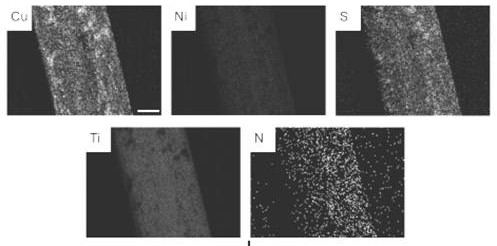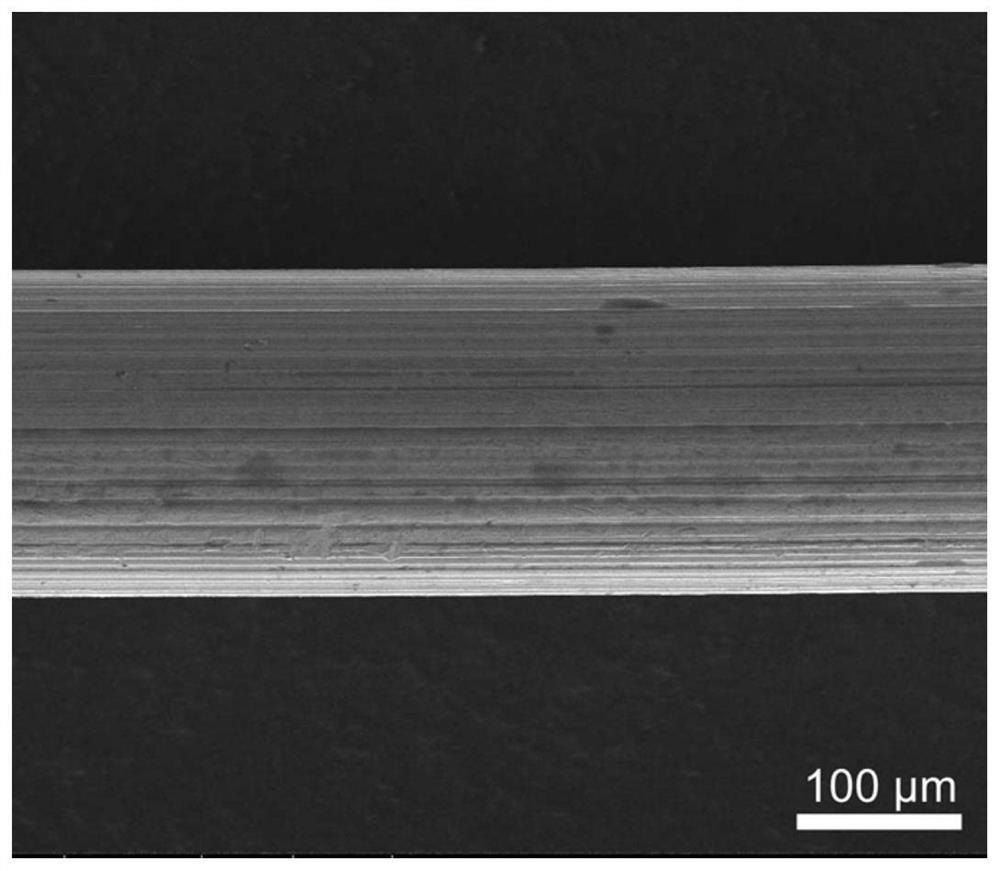Memory alloy esophageal stent modified by nano copper sulfide coating and preparation method of memory alloy esophageal stent
A memory alloy and copper sulfide technology, used in coatings, stents, pharmaceutical formulations, etc., can solve the problems of tumor restenosis and inability to treat tumors, and achieve the effects of simple treatment process, good photothermal conversion effect, and stable properties.
- Summary
- Abstract
- Description
- Claims
- Application Information
AI Technical Summary
Problems solved by technology
Method used
Image
Examples
Embodiment 1
[0037] A preparation method for growing copper sulfide nanoparticles in situ on a nickel-titanium alloy wire, comprising the following steps:
[0038] 1) Preparation of dopamine-coated nickel-titanium stent: firstly, the surface of the nickel-titanium alloy stent was cleaned, and then the stent was immersed in 8 mM Tris-HCl buffer solution (pH 8.5). Add dopamine to the solution to make the final solubility 2 mg / mL, and stir rapidly in the dark for 8 hours; take out the stent, and wash the polydopamine-coated stent three times with deionized water.
[0039] 2) Submerge the dopamine-coated stent in a beaker containing 400mL of 0.5mg / mL PVA solution, stir at 1000rpm for 20min, then add 150mg of CuSO 4 ·5H 2 O and 75 mg Na 2 S 2 o 3 ·5H 2 O was added to the PVA solution to give a green colloidal solution.
[0040] 3) Next, the mixture was heated to 80°C and kept for 2h. After the reaction, let it cool down to room temperature naturally, take out the product and rinse it wit...
Embodiment 2
[0042] A preparation method for growing copper sulfide nanoparticles in situ on a nickel-titanium alloy wire, comprising the following steps:
[0043] 1) Preparation of dopamine-coated nickel-titanium stents: firstly, after cleaning the surface of the nickel-titanium alloy stents, immerse the stents in 10mM Tris-HCl buffer (pH 8.5), and add dopamine to the solution to make the final solubility 5mg / mL, and stirred rapidly for 12 h in the dark; take out the stent, and wash the polydopamine-coated stent three times with deionized water.
[0044] 2) Submerge the dopamine-coated stent in a beaker containing 400mL of 3mg / mL PVA solution, stir at 1000rpm for 30min, then add 300mg of CuSO 4 ·5H 2 O and 150 mg Na 2 S 2 o 3 ·5H 2 O was added to the PVA solution to give a green colloidal solution.
[0045]3) Next, the mixture was heated to 80°C and kept for 2h. After the reaction was completed, it was allowed to cool down to room temperature naturally. The product was taken out ...
Embodiment 3
[0047] A preparation method for growing copper sulfide nanoparticles in situ on a nickel-titanium alloy wire, comprising the following steps:
[0048] 1) Preparation of dopamine-coated nickel-titanium stent: firstly, the surface of the nickel-titanium alloy stent was cleaned, and then the stent was immersed in 10 mM Tris-HCl buffer solution (pH 8.5). Add dopamine to the solution to make the final solubility 5mg / mL. Stir rapidly in the dark for 8 hours; take out the stent, and wash the polydopamine-coated stent three times with deionized water.
[0049] 2) Submerge the dopamine-coated stent in a beaker containing 400mL of 5mg / mL PVA solution, stir at 1000rpm for 20min, then add 150mg of CuSO 4 ·5H 2 O and 75 mg Na 2 S 2 o 3 ·5H 2 O was added to the PVA solution to give a green colloidal solution.
[0050] 3) Next, the mixture was heated to 80°C and kept for 2h. After the reaction was completed, it was allowed to cool down to room temperature naturally. The product was ...
PUM
| Property | Measurement | Unit |
|---|---|---|
| particle diameter | aaaaa | aaaaa |
| diameter | aaaaa | aaaaa |
| length | aaaaa | aaaaa |
Abstract
Description
Claims
Application Information
 Login to View More
Login to View More - R&D
- Intellectual Property
- Life Sciences
- Materials
- Tech Scout
- Unparalleled Data Quality
- Higher Quality Content
- 60% Fewer Hallucinations
Browse by: Latest US Patents, China's latest patents, Technical Efficacy Thesaurus, Application Domain, Technology Topic, Popular Technical Reports.
© 2025 PatSnap. All rights reserved.Legal|Privacy policy|Modern Slavery Act Transparency Statement|Sitemap|About US| Contact US: help@patsnap.com



